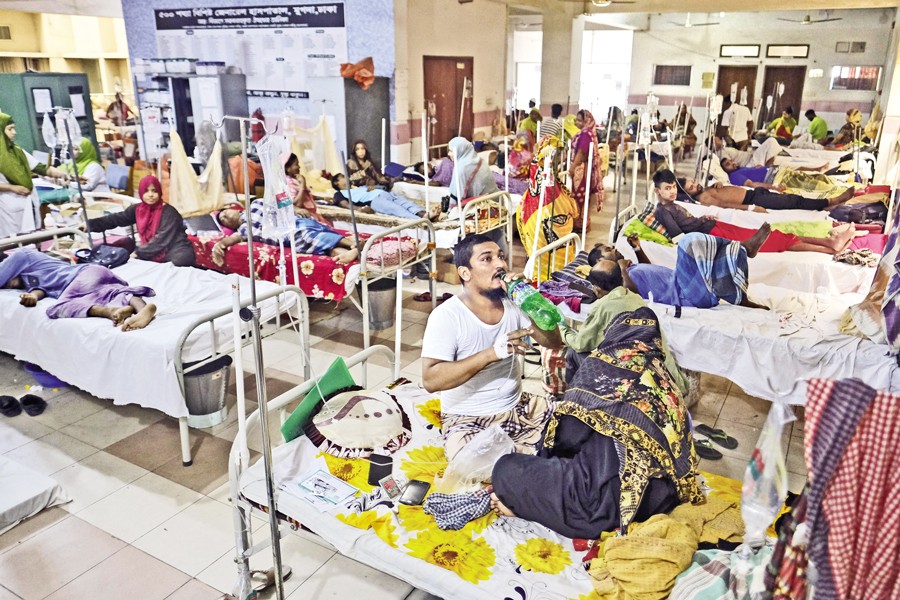 Patients suffering from dengue receive treatment at Mugda Medical College and Hospital in Dhaka, Bangladesh on Aug 10, 2023 — Agency Photo
Patients suffering from dengue receive treatment at Mugda Medical College and Hospital in Dhaka, Bangladesh on Aug 10, 2023 — Agency Photo  Bangladesh is tangibly deficient in providing better healthcare to its burgeoning population. So far, universal healthcare remains a far cry in the country, with resultant rise in foreign medical bills. Government expenditure for healthcare is much lower than in other nations, even in the South Asian countries. According to WHO, Bangladesh is one of the ten countries with the lowest health expenditure. The national budget 2020-21 had an allocation of 5.0 per cent of the outlay for the healthcare sector, accounting for less than 1.0 per cent of GDP. The per-capita health expenditure in Bangladesh is just US$45, while it is $58 in Nepal, $73 in India, $103 in Bhutan and $157 in Sri Lanka. Experts say that the health budget should comprise at least 8.0 per cent of the budgetary allocation.
Bangladesh is tangibly deficient in providing better healthcare to its burgeoning population. So far, universal healthcare remains a far cry in the country, with resultant rise in foreign medical bills. Government expenditure for healthcare is much lower than in other nations, even in the South Asian countries. According to WHO, Bangladesh is one of the ten countries with the lowest health expenditure. The national budget 2020-21 had an allocation of 5.0 per cent of the outlay for the healthcare sector, accounting for less than 1.0 per cent of GDP. The per-capita health expenditure in Bangladesh is just US$45, while it is $58 in Nepal, $73 in India, $103 in Bhutan and $157 in Sri Lanka. Experts say that the health budget should comprise at least 8.0 per cent of the budgetary allocation.
Actually, the government's main priority in recent years is infrastructure development focused on road, bridge, power, school and college development. It's spending on education and health is still very low. Therefore, the public investment in health-service expansion is much lower than in other countries. The government has thus far established a few specialized hospitals and multi-specialised hospitals across the country. The government hospitals cannot serve a large number of patients crowding for treatments every day.
So, private sector should come forward simultaneously with the public sector. Bangladeshi corporates, foundations and trusts can come forward with their services to bolster the healthcare system here as many people cannot bear their expenditures. India could be a good model for Bangladesh to emulate. Growing numbers of people from here go to the neighbouring country for treatments.
Indian Model: Public health expenditure in India, including that by both the central and state governments, was maintained constantly at approximately 1.3 per cent of GDP between 2008 and 2015 and increased marginally to 1.4 per cent in the 2016-17 fiscal.
The Indian National Health Policy 2017 proposed to increase this figure to 2.5 per cent by 2025. The total health expenditure, including in the private sector, is estimated to be 3.9 per cent of the total GDP. About one-third of the total health expenditure (30 per cent) comes from the public sector. This is yet lower compared to the corresponding figures for other developing and developed countries. This implies that the individual consumer bears the cost of their healthcare. Like in Bangladesh, Indian public investment in health service is also low compared to the huge demand in the country.
To cater the huge demand for health services, the private sector has come forward in India. Many of them are "for-profit" and some of them "not-for-profit" organisations. Most of the not-for-profits are set up by trust and foundations in India.
A study on "Not-for-Profit Hospital Model in India", conducted by NITI Aayog in June 202, has shown that not-for-profit hospitals from the private sector lie in four categories. They are (1) Faith-based Hospitals (2) Community-based Hospitals (3) Cooperative Hospitals, and (4) Private Trust Hospitals. Different corporate companies, temples and private sector-based trusts and foundations have set up hundreds of hospitals and healthcare systems across India.
Faith-based hospitals: Under this model, the hospitals work on the premise that selfless service to society is done as service to god. A noteworthy feature of all major faiths has been their emphasis on charity and sharing wealth with others, especially the have-nots. Throughout the ancient and medieval ages, voluntary activity had found its natural expression through religious institutions, especially Mandir Trust-based hospitals. This concept further accelerated with the advent of western influence and presence in India. Individual missionaries or religious trusts have founded many such hospitals based on the principles of religions or deities.
Under the model, the mandir-based hospitals are serving millions of patents, especially the underprivileged ones, with a minimal cost and full or partial charity when required. In these types of hospitals, there are few private wards where affording patients pay slightly more than basic costs.
Hundreds of hospitals in different states of India have already been set up. Most of the hospitals are established based on religious belief. They are run by mandir trusts. For example, the Sai Baba Hospital in Bengalore, the Mahavir Cancer Sangsthan in Patna, the Shree Devi Talab Mandir Charitable Hospital, Sri Sathya Sai Institute of Higher Medical Sciences in Bangalore, and Shram Mandir Hospital in Gujrat.
Like others, the Mahavir Cancer Sangsthan in Patna is one of the Mandir trust-based hospitals in India. I have visited the hospital recently and tried to understand the health- service model of it. The hospital, also called Mahavir Cancer Sangsthan and Research Centre (MCSRC), is mainly a cancer-treatment provider. Director of the hospital Dr (Prof) Biswajit Sanyal said, "The patients are not only from Bihar and adjacent states of India, some from Bangladesh, Nepal and Bhutan come to have treatment. The hospital has world-class treatment facilities, lab facilities, and cancer-patient care which are among the best services in India."
According to the hospital director, Prof Sanyal, it treats around 25-30 thousand new patients and few hundred thousand old patients every year. The Mahavir Cancer Sangsthan is a 650-bed hospital, where 27 ICUs, 11 operating theatres, a bone-marrow transplant unit, surgical and radiation units are there too. Separate chemotherapy units are also available for the adult patient as well as for the child. Dr Sanyal said their Mahavir Mandir Trust is also working on a separate cancer hospital for child patients in Patna which is expected to be ready within next one year. Their main mission is -"no patient will be left without treatment." It's totally a subsidized hospital. "For poor patients, we give all treatments free of cost. Although it's a subsidized hospital, but we maintain our management costs from patient earnings," the director of the hospital added. He said they serve a large number of patients every month, so the earnings from them cover their management costs.
"Although the MCSRC has cared the patients at lower costs, but it never compromises our excellence as it has international-standard machinery like the cobalt and AI-supported ones for radiation therapy for the cancer patients. It also has a mobile blood bank which supports our patients, especially the poor ones, at very nominal costs," Dr Sanyal said. The Mahavir Hospital has built two separate residential facilities adjacent to the hospital for the local and foreign patients who avail staying at very nominal costs, he said.
Like Mahavir Cansar Sangthan in Patna, almost all the Mandir-based hospitals are giving best treatments to the underprivileged as well as to the general people.
Community-based Hospitals: These hospitals are not necessarily influenced by any faith but operate on the premise that selfless service to the underprivileged will result in all-round social reform. Highly motivated doctors, or a team of like-minded doctors, desiring to give back to society, have founded many such hospitals, often in the same community where they were born or raised.
These types of hospitals have a large number of general wards, where underprivileged patients pay minimal costs and receive full/partial charity when required. Few private wards are there, where affording patients pay slightly more than basic costs.
Cooperative Hospitals: These hospitals are set up on the premise of self-sufficiency in healthcare by self-participation. They believe that quality healthcare at an affordable cost (commensurate with the locality of the hospital) is a right of all citizens and can result in the overall benefit of both the hospital and its patients. Individual doctors or a like-minded team of doctors convinced of the same philosophy have founded many such hospitals. They invite patients and their families to pay a membership fee - either annual/ or lifetime/ or through purchase of hospital shares/ or as a hospital-run insurance scheme, through which the members obtain substantial discounts in out-patient/ in-patient treatment, investigations and medications.
These types of hospitals give priority to non-emergency services to the patients enrolled as members. They engage the local population through various projects focused on health awareness and education, camps for senior citizens, and vulnerable citizens.
Private Trust Hospitals: These hospitals operate with the premise of no profit, no loss and are primarily located in the comparatively richer cities. Famous businessmen or philanthropists or politicians have founded many such hospitals in response to social causes based on individually observed needs. They have highly advanced infrastructure with the latest technology. They provide high-quality care at slightly less or at-par-with market rates to all patients. They have a designated indigent patient fund for the treatment of non-affording patients based on documentary verification. They have separate pricing structures for international patients and underprivileged patients. Their capital expenditure is funded from the revenue of the hospital and donations received from philanthropists.
Prospect of Indian Model to Bangladesh: Bangladesh is far behind from the better healthcare and its public sector cannot provide adequate health services to the people, especially to those in low-income class. Although it has some better healthcare system in the private sector, but mostly is situated in the capital city. In addition, their treatment and health-service costs are not affordable to a big section of the population. So, the poor, lower- middle-class people cannot get treatment from these private hospitals.
The India model comprising Faith-based Hospitals, Community-based Hospitals, Cooperative Hospitals and Private Trust Hospitals could work here. Bangladesh is a land of mosques. It has hundreds of mosques in every big city. Many mosques have complex with educational facilities and social services. The mosque-based complex can expand their services in the health sector too. Some big mosques could set up trust and then can set up hospitals. Many philanthropies and corporate establishments provide grants from their funds. So, the mosque complex could get those funds for operating their hospitals across the country, especially in the under-privileged areas.
Besides, the charity organisations or the corporates should come forward with their funds for setting up hospitals aimed at serving people who are not getting better treatment inside the country. Indian Tata, Reliance and others have already come forward and set up world- standard hospitals in different cities for patient care. I think Bangladesh's mosque-based foundations, complexes or trusts, and the corporate institutions should come forward for healthcare in addition to the government sector. The public sector alone could not cater the demand for healthcare for the huge number of 170 million people in Bangladesh.
The writer is a senior journalist and development analyst. He can be reached at: kabirhumayan10@gmail.com
© 2026 - All Rights with The Financial Express
